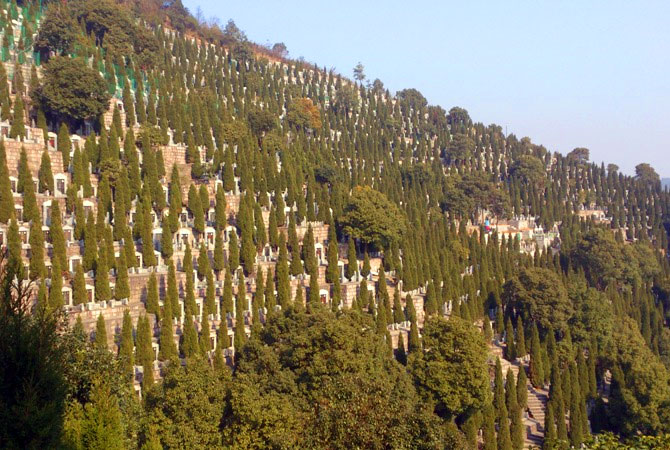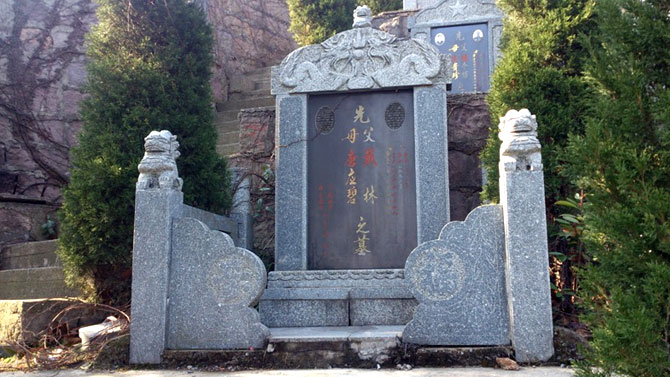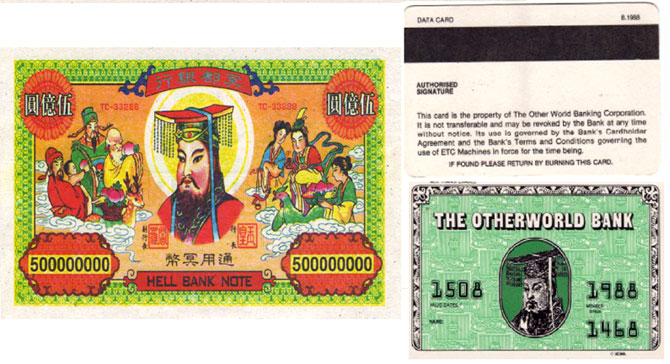 | « Back to article | Print this article |
How the Chinese remember their dead
Paper houses, models of BMWs and 'hell money' are just some of the offerings the Chinese make to their dead says Priyankar Bhunia.
In whichever direction you glance, there are rows upon rows of grey headstones arranged upon the hillsides, rising out of the early morning mist.
There is smoke curling up from several points on the hills.
The temperature is close to subzero levels but the place is crowded with families coming out to pay their respects to the dead.
It is December 21, 2013, the winter solstice and I am at a cemetery in Hangzhou, China, with my wife (who is Chinese) and parents-in-law.
We are here in the service of an oxymoron, to make offerings for the material comfort of the spirits.
You might expect the burial plots on the lower levels to be more highly valued, due to the ease of access.
But it's the other way round, with the prices determined from the perspective of the deceased ancestors.
The plots higher up command a higher price, due to the better views.
Our destination was midway on one of the hills.
After trudging uphill for nearly half an hour in freezing cold (the cemetery management company plans to build an escalator on the hillside soon for the convenience of the living. Unlike Indian pilgrimages, there is no spiritual merit associated with the exertion of walking up a hill), we reached the grave of my wife's grandfather.
Beside it, there was an already purchased plot for her grandmother, to ensure that the grandparents can be together in the afterlife.
Plots are purchased way in advance, sometimes when people are in their 40s or 50s, to grab the prime real estate.
The graves are around one-fourth the size of regular graves.
That's because none of them have bodies buried underneath. They contain urns of ashes.
In many parts of China, cremation is mandatory by law.
From the early communist era, the government encouraged cremation in place of burials to save farm land.
ALSO READ Year of the Horse: Chinese New Year predictions
How the Chinese remember their dead
Buddhist scriptures don't prescribe either burial or cremation but tradition is in favour of the latter.
However, as per traditional Chinese beliefs, the body should return to its natural place in the earth.
In the heavily crowded cities, cremation is the norm, but burial is still practiced extensively in the countryside.
We swept the grave and placed fresh flowers.
Then the most interesting part of the ritual began.
Along with joss paper or hell money, we also burnt a gold coloured Hell credit card with Visa embossed on it, a papier-mache model of a bungalow, a certificate of ownership for the aforementioned bungalow, with grandpa and grandma's name on it and a paper car with a driver, in a solemn ceremony, to ensure a comfortable stay for the deceased in the underworld.
Bottles of his favourite drinks and lit cigarettes were also placed on the grave.
Some of the hell money and cigarettes were offered to the neighbouring graves, so that the deceased would have good relations with his neighbours.
Paper/cardboard models of all sorts of items are burnt.
A sample list from Taobao (China's version of Amazon and Ebay rolled into one) of replicas which could be offered (1 RMB equals approximately 10 INR):
- Jacket: RMB 1.6, Shoes: RMB 2
- Basket of imperial gold coins: RMB 12
- Furniture set with bed and wardrobe: RMB 3
- House: RMB 5 Or Collapsible three storey villa (for those accustomed to luxury): RMB 36
- Bottle of wine with set of glasses: RMB 2
- Games and sports equipment (chess set, cards, mah-jong, billiards, badminton racquet, basketball, tennis racquet and ball, rugby ball): RMB 4
- Men's accessory set (BMW car, iPhone, Rolex watch, gold fountain pen, eyeshades, snuff bottle): RMB 4
The term 'hell money' is misleading, as the Chinese vision of the underworld is very different from the Western one.
Basically, everyone goes to the so called 'hell' after death.
When the Christian missionaries reached China, they started preaching that non-believers would go to hell. But hell was interpreted as the afterlife.
The notes have the Hell bank of China imprinted on them as the issuing bank and are made to resemble Yuan notes or even US Dollars or Euros these days.
They are printed in large denominations, reaching up to 1 million or even higher, giving rise to speculation that hell must be suffering from hyperinflation by now.
While the tradition of burning hell money has been practiced since at least the late 19th century, burning replicas of luxury goods is a relatively recent phenomenon.
This is indicative of how far China has come from its days of forced Communist austerity under Mao.
When my parents-in-law showed 92-year old grandma a photograph of a toy poodle they got recently, her reaction was telling.
She exclaimed, "Only capitalist bourgeoisie keep dogs".
It has been a rather short journey from such sentiments to the present day, where Chinese citizens account for nearly a quarter of global luxury goods sales.
The world of the spirits or souls is perceived to be similar to the world of the living, the system of judgement and punishment paralleling a government bureaucracy.
Here, comes in the concept of burning hell money, so that the dead can have a good afterlife, maybe also use it to bribe the officials of the nether-worlds to get a better deal.
In Hinduism, the actions of the family, in terms of prescribed scriptural rituals, facilitate the passage of the soul.
In the Chinese belief system, the role played by the family is equally crucial. The dead, if forgotten, could have a really difficult time, living an afterlife of abject poverty.
How the Chinese remember their dead
The Chinese visit cemeteries to tend to the graves of the departed during the Qingming festival usually in April, commonly known as Ancestors' day or Tomb Sweeping day. But it can be done on other appointed days also, as we did that day.
The Chinese beliefs about death and the after-life, are drawn from ancient folk religions, Taoism and Mahayana Buddhism (the last in turn is influenced by Hinduism).
After death, the spirit is taken to the underworld, where the individual's deeds during his/her lifetime are tallied and judgement is pronounced.
The god of death, Yama, is the same as in Hindu mythology.
Apparently, Yama's officials include a judge who keeps an account of all souls and their deeds. He would be the Buddhist version of the Hindu deity, Chitragupta.
While the virtuous are fast-tracked to one of the levels of heaven or to the next rebirth, sinners spend an appropriate amount of time, suffering the punishment for their sins in one of the multiple levels of hell, before drinking a potion, which erases their memory.
Subsequently, they move on to their next form on earth, which could be human or animal (In Mo Yan's brilliant historical satire, Life and death are wearing me out, a landlord is reborn as a donkey, ox, pig, dog and a monkey in sequence). The ultimate salvation in the form of Nirvana, freedom from the cycle of birth and death is out of reach for the masses.
As we walked down the steps, I wondered, how and why all these fascinating rituals were created, whether it's observing sraddha, sitting Shiva (in Judaism) or making material offerings to the ancestors.
Across cultures and civilisations, maybe these are primarily designed to comfort the living.
To convince themselves that death is not the end, to give them the feeling that they have done their duties and fulfilled their obligations and to reassure them that someone will do the same for them.


